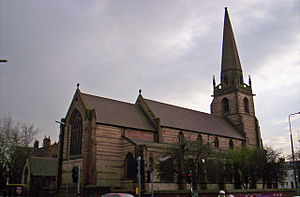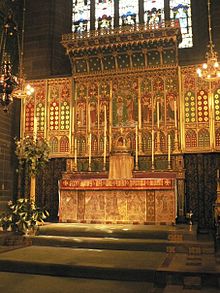- Church of Saint John the Baptist, Liverpool
-
Church of Saint John the Baptist, Liverpool 
Church of Saint John the Baptist, Liverpool53°25′29″N 2°55′48″W / 53.4248°N 2.9301°WCoordinates: 53°25′29″N 2°55′48″W / 53.4248°N 2.9301°W Location Tuebrook, Liverpool, Merseyside Country England Denomination Anglican Churchmanship Anglo-Catholic Architecture Status Parish church Functional status Active Heritage designation Grade I Designated 28 June 1958 Architect(s) George Frederick Bodley Architectural type Church Style Gothic Revival Groundbreaking 1867 Completed 1870 Construction cost £25,000 Specifications Materials Red and buff stone
Tile and slate roofsAdministration Deanery West Derby Archdeaconry Liverpool Diocese Liverpool Province York The Church of Saint John the Baptist, Liverpool, is on the corner of West Derby Road and Green Lane, in Tuebrook, Liverpool, Merseyside, England (grid reference SJ382924). It is a Grade I listed building[1] and an active Anglican parish church in the diocese of Liverpool, the archdeaconry of Liverpool and the deanery of West Derby.[2]
Contents
History
The church was built between 1867 and 1870, its cost of £25,000 (£1,773,543 as of 2011),[3] being totally met by the wife of Rev. J. C. Reade. The architect was George Frederick Bodley. The interior was redecorated in 1910 by Henry Hare to Bodley's design. This was restored in 1968–71 by Stephen Dykes Bower.[4]
There was controversy before the church was consecrated because Bodley intended to use an early 16th century altarpiece from Antwerp which had carved tableaux of the Passion as the reredos. However the Bishop of Chester considered it to be too "Popish" and he refused to consecrate the church until it was removed. The altarpiece is now in St Michael's Church, Brighton.[4]
Structure
The church is built in red and buff stone, which is irregularly banded.[4] The main roof is tiled, while the roofs of the aisles are of slate. Its plan consists of a five-bay nave with a clerestory, north and south aisles under lean-to roofs, a west tower, a north porch, a chancel with a chapel to the north, the organ loft to the south and a detached vestry connected to the chancel by a short passage. The tower has angled buttresses and a west entrance above which is a three-light window. The top stage has two-light louvred bell-openings and a panelled parapet with pinnacles at the corners.[1] The spire is recessed on an octagonal base containing gabled two-light openings and it is attached to the pinnacles by flying buttresses.[1][4] At the south east corner of the tower is a lean-to stair turret. The porch has a flat roof with a parapet and a niche over the entrance containing a statue.[1]
Decoration, fittings and furnishings
Pollard and Pevsner describe the interior as being "glorious" and "richly coloured" due to the "resplendent display of Bodley fittings and the vibrant decoration".[4] The citation in Images of England states it is "one of the finest examples of Victorian polychromy".[1] The walls and the roofs are all richly stencilled, and in addition there is a wall painting on the east wall of the nave by C. E. Kempe. The gilt reredos dates from 1871 and has panels painted by Kempe.[4]
The area under the tower has made into the Chapel of the Holy Rood and contains a reredos, an altar and a credence table which were adapted in 1978 from a rood screen of 1890 by Bodley which was taken from Dunstable Priory.[1][4] The pulpit and the octagonal font were both designed by Bodley, as were the richly painted screens (again with panels by Kempe). The stained glass in the east window and the south window in the chancel is by Morris & Co.; some of the windows elsewhere are by Burne-Jones. In the church is a brass memorial dating from 1926 by Hare which consists of a life-size figure of Rev. Ralph Brockman. The memorial to the First World War is a statue of Mary, also by Hare; that to the Second World War is a statue of John the Baptist by Sir Ninian Comper.[4]
The ring consists of eight bells which were cast in 1869 by John Warner & Sons.[5]
Organ
The three-manual organ was made by William Hill & Sons in 1867 and cleaned and improved by the same company in 1895. It is contained in a "magnificent Bodley case, with embossed display pipes".[6] It was restored in 1991 by David Wells.
List of organists
- Claude Ridley 1871-1882
- William Faulkes(organist-composer)1882 - 1886[7]
- R.Cooper ARCO, 1896-
- Mr Tubb (senior), 1901–1933
- C.F. Holt, 1935–1953
- Edward Tubb 1953-1956
- C.F. Holt 1956-1966
- David James (Assistant Organist 1966 then Organist from 1973-)
- Clive Arnold 2000-2009
- John Peace BA LRAM ARCO 2009-
-
This list is incomplete; you can help by expanding it.
Vicarage
The vicarage, completed in 1890, was also designed by Bodley.[4] It is a Grade II listed building in grey brick with red brick bands and red sandstone dressings. It has three storeys and a tile roof.[8]
References
- ^ a b c d e f Images of England: Church of St John the Baptist, English Heritage, http://www.imagesofengland.org.uk/details/default.aspx?pid=1&id=359734, retrieved 8 October 2008
- ^ Deanery of West Derby, The Diocese of Liverpool, http://www.liverpool.anglican.org/index.php?p=381, retrieved 8 October 2008
- ^ UK CPI inflation numbers based on data available from Lawrence H. Officer (2010) "What Were the UK Earnings and Prices Then?" MeasuringWorth.
- ^ a b c d e f g h i Pollard, Richard; Nikolaus Pevsner (2006), The Buildings of England: Lancashire: Liverpool and the South-West, New Haven & London: Yale University Press, pp. 477–479, ISBN 0 300 10910 5
- ^ Liverpool, Tuebrook, S John Bapt, Dove's Guide for Church Bell Ringers, http://dove.cccbr.org.uk/detail.php?searchString=liverpool&Submit=++Go++&DoveID=LIVERPLTB, retrieved 8 October 2008
- ^ Liverpool-Tuebrook, St. John, British Institute of Organ Studies, http://www.npor.org.uk/cgi-bin/Rsearch.cgi?Fn=Rsearch&rec_index=D01829, retrieved 8 October 2008
- ^ Dictionary of Organs and Organists. First Edition. 1912. p.273
- ^ Images of England: Vicarage of St John Baptist, English Heritage, http://www.imagesofengland.org.uk/details/default.aspx?pid=1&id=359735, retrieved 8 October 2008
External links
 Media related to Church of Saint John the Baptist, Liverpool at Wikimedia CommonsCategories:
Media related to Church of Saint John the Baptist, Liverpool at Wikimedia CommonsCategories:- Churches in Liverpool
- Grade I listed buildings in Liverpool
- Grade I listed churches
- Church of England churches in Merseyside
- Anglican Diocese of Liverpool
- Gothic Revival architecture in Merseyside
- Religious buildings completed in 1870
- 19th-century church buildings
Wikimedia Foundation. 2010.

